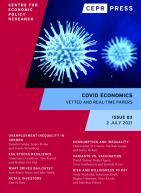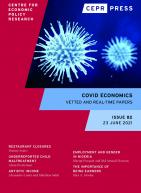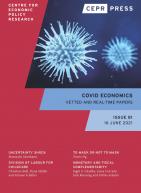
I calibrate a Multi-Risk SIR model on the covid pandemic to analyze the impact of the age-specific confinement and PCR testing policies on incomes and mortality. Two polar strategies emerge as potentially optimal. The suppression policy would crush the curve by confining 90% of the population for 4 months to eradicate the virus. The flatten-the-curve policy would reduce the confinement to 30% of the population for 5 months, followed by almost one year of free circulation of the virus to attain herd immunity without overwhelming hospitals. Both strategies yield a total cost of around 15% of annual GDP when combining the economic cost of confinement with the value of lives lost. I show that hesitating between the two strategies can have a huge societal cost, in particular if the suppression policy is stopped too early. Because seniors are much more vulnerable, a simple recommendation emerges to shelter them as one deconfines young and middle-aged people in order to build our collective herd immunity. By doing so, one reduces the death toll of the pandemic together with the economic cost of the confinement, and the total cost is divided by a factor 2. I also show that expanding the mass testing capacity to screen people sent back to work has a large benefit under various scenarios. This analysis is highly dependent upon deeply uncertain epidemiologic, sociological, economic and ethical parameters.
Citation
Gollier, C (2020), ‘Cost-benefit analysis of age-specific deconfinement strategies‘, COVID Economics 24, CEPR Press, Paris & London. https://cepr.org/publications/covid-economics-issue-24#392514_392900_390485
Many countries around the world have implemented stringent containment measures to halt the spread of the 2019 coronavirus disease (Covid-19) and limit the number of fatalities. Though crucial to slow the course of the pandemic, these measures entail large short-term economic costs. This paper tries to quantify these effects using daily data on real-time containment measures implemented by countries around the world as well as daily indicators of economic activity such as Nitrogen Dioxide (NO2) emissions, international and domestic flights, energy consumption, maritime trade, and retail mobility indices. Results suggest that containment measures have had, on average, a very large impact on economic activity—equivalent to a loss of about 15 percent in industrial production over a 30-day period following the implementation of containment measures. Using a novel database on discretionary fiscal and monetary policy measures implemented by countries in response to the crisis, we find that these policy measures have been effective in mitigating some of these costs. Finally, we find that among different types of containment measures, while stay-at-home requirements and workplace closures are the most effective in curbing both infections and deaths, they are also those associated with the largest economic costs.
Citation
Tawk, N, D Furceri, J Ostry and P Deb (2020), ‘The economic effects of COVID-19 Containment Measures‘, COVID Economics 24, CEPR Press, Paris & London. https://cepr.org/publications/covid-economics-issue-24#392514_392900_391039
We test whether earlier social distancing affects the progression of a local COVID-19 outbreak. We exploit county-level rainfall on the last weekend before statewide lockdown. After controlling for historical rainfall, temperature, and state fixed-effects, current rainfall is a plausibly exogenous instrument for social distancing. Early distancing causes a reduction in cases and deaths that persists for weeks. The effect is driven by a reduction in the chance of a very large outbreak. The result suggests early distancing may have sizable returns, and that random events early in an outbreak can have persistent effects on its course.
Citation
Xu, G, A Shenoy, H Rho, K Sangha and R Kapoor (2020), ‘God is in the Rain: The Impact of Rainfall-Induced Early Social Distancing on COVID-19 Outbreaks‘, COVID Economics 24, CEPR Press, Paris & London. https://cepr.org/publications/covid-economics-issue-24#392514_392900_390486
We analyse how air traffic across countries contributed to the propagation of COVID-19 by fitting a Spatial Durbin-Watson model adapted to local projections. Such a model explicitly accounts for spatial dependence of observations and allows to track the effect of domestic and foreign new infections over time. Our estimates show that air travel-induced cases amount to 8-9% of all confirmed cases on average, and that these infections from abroad came in two waves: in mid-March and the fourth week of March. We also evaluate that air travel restrictions had a marked impact in reducing the progression of the pandemic from April onward. Closing all air traffic 4 weeks earlier could have prevented between 7,000 and 7,800 deaths. Based on standard values of a statistical life and on the latest estimates of GDP loss induced by air travel restrictions, we conclude that, just as social distancing, spatial distancing might be a cost-effective way to tackle COVID-19 in the short run.
Citation
Hubert, O and N Gonne (2020), ‘Spatial distancing: air traffic, COVID-19 propagation, and the benefits of air travel restrictions‘, COVID Economics 24, CEPR Press, Paris & London. https://cepr.org/publications/covid-economics-issue-24#392514_392900_390487
Time series models are developed for predicting future values of a variable which when cumulated is subject to an unknown saturation level. Such models are relevant for many disciplines, but here attention is focussed on the spread of epidemics and the applications are for coronavirus. The time series models are relatively simple but are such that their specification can be assessed by standard statistical test procedures. In the generalized logistic class of models, the logarithm of the growth rate of the cumulative series depends on a time trend. Allowing this trend to be time-varying introduces further flexibility and enables the effects of changes in policy to be tracked and evaluated.
Citation
Kattuman, P and A Harvey (2020), ‘Time Series Models based on Growth Curves with Applications to Forecasting Coronavirus‘, COVID Economics 24, CEPR Press, Paris & London. https://cepr.org/publications/covid-economics-issue-24#392514_392900_390488
Stay-at-home orders (SAHOs) have been implemented in most U.S. states to mitigate the spread of COVID-19. This paper quantifies the short-run impact of these containment policies on search behavior and labor demand for child care. The child care market may be particularly vulnerable to a SAHO-type policy shock, given that many providers are liquidity-constrained. Using plausibly exogenous variation from the staggered adoption of SAHOs across states, we find that online job postings for early care and education teachers declined by 13% after enactment. This effect is driven exclusively by private-sector services. Indeed, hiring by public programs like Head Start and pre-kindergarten has not been influenced by SAHOs. In addition, we find little evidence that child care search behavior among households has been altered. Because forced supply-side changes appear to be at play, our results suggest that households may not be well-equipped to insure against the rapid transition to the production of child care. We discuss the implications of these results for child development and parental employment decisions.
Citation
Herbst, C, C Makridis and U Ali (2020), ‘The Impact of COVID-19 on the U.S. Child Care Market: Evidence from Stay-at-Home Orders‘, COVID Economics 24, CEPR Press, Paris & London. https://cepr.org/publications/covid-economics-issue-24#392514_392900_390489
The outbreak of the Coronavirus Disease 2019 (COVID-19) is inevitably affecting remittance-dependent countries through economic downturns in the destination countries, and restrictions on travel and sending remittances to their home country. This paper explores the potential impacts of the COVID-19 pandemic on the welfare of remittance-dependent households using a dataset collected in heavily remittance-dependent regions in the Philippines prior to the outbreak. First, the empirical model pins down the relationship between the macroeconomic performance of the destination countries, the amount of remittances, and the welfare of households. Second, we use the difference in the IMF’s forecasts for the 2020 GDP before and after the COVID-19 crisis to project potential impacts on households caused by the COVID-19 pandemic. Our projection shows that remittance inflow will decrease by 23-32% and household spending per capita will decline by 2.2-3.3% in one year as a result of the pandemic.
Citation
Shimizutani, S, E Yamada and E Murakami (2020), ‘The Potential Impact of the COVID-19 Pandemic on the Welfare of Remittance-Dependent Households in the Philippines‘, COVID Economics 24, CEPR Press, Paris & London. https://cepr.org/publications/covid-economics-issue-24#392514_392900_390490
We evaluate the effects of containment measures on flattening the COVID-19 infection curve in Germany. Constructing a regional daily panel dataset, we make use of the fact that different containment measures were implemented by the German state governments at different times and not uniformly nationwide. The results show that the cancellation of mass events, school and childcare closures and curfews played an important role, just as further unobserved factors beyond government interventions. In contrast, we find only limited evidence for additional effects of the closures of service sectors in public life.
Citation
Weber, E (2020), ‘Which measures flattened the curve in Germany?‘, COVID Economics 24, CEPR Press, Paris & London. https://cepr.org/publications/covid-economics-issue-24#392514_392900_390491


Covid Economics - Issue 82
- Restaurant Closures during the Pandemic: A Descriptive Analysis
- Underreporting Child Maltreatment during the Pandemic: Evidence from Colorado
- Covid-19 impact on Artistic Income
- COVID-19, Employment, and Gender: Evidence from Nigeria
- The Importance of Being Earners: Modelling the Implications of Changes to Welfare Contributions on Macroeconomic Recovery
